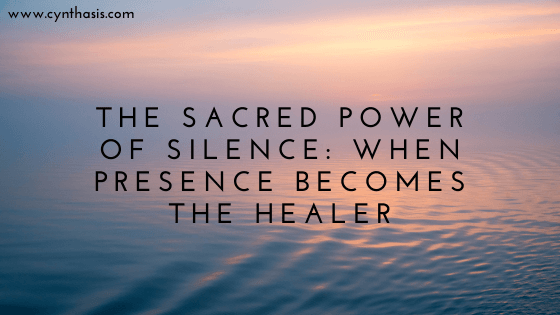The Sacred Power of Silence: When Presence Becomes the Healer
How Neuroscience, Stillness, and Soulful Witnessing Invite Deep Transformation
Sometimes the most powerful thing we can do is simply be there.
In the symphony of therapeutic approaches that fill our professional lives, sometimes it’s the rests between notes—the silences—that create the most profound resonance. As therapists, we’re trained to listen, interpret, and respond. But what if our most powerful intervention is sometimes no intervention at all?
The Neuroscience of Bearing Witness
Dr. Huberman’s, (a Stanford University School of Medicine professor of neurobiology and ophthalmology and a tenured neuroscientist) discussion on neuroplasticity in his podcast, How to Focus to Change Your Brain, gives us a window into why presence works at the neural level. When we create a space of attentive silence, our brains change when specific neurochemicals are released that allow neurons to strengthen or weaken their connections. This happens most powerfully when we direct our complete attention to an experience.
The therapeutic room is a great place for such changes. As therapists, when we silently bear witness to our clients’ stories and emotions, we’re helping them create the conditions for their brains to make new connections, neuroplasticity. We’re offering them a chance to maintain that precious “cone of attention” where specific neural circuits in the chemistry of change can take place.
Beyond Words: The Sacred Space of Non-Intervention
Think about it. If you’re not busy thinking of what to interpret and say to your client, and your client has focused attention, there is space for true healing. It’s like neuroscience is meeting ancient wisdom. Long before, therapists sat in stillness while another shared breath, emotion, and spirit. This silent witnessing is a sacred act of listening with the whole body. Silence is often the medium through which healing happens. How often have you sat and listened to another and they were deeply grateful for the opportunity to be heard and understood? Our presence offers much more than we realize.
In the Brainspotting world, the therapist is trained to sit in silence, offering time and space for the person to discover things a therapist’s wise mind may never have come up with. I remember looking at the power of silence with a neurofeedback machine. I was giving a colleague a session (we were contemplating a research project) and when I thought it was time to speak, I said something very gentle and affirming, but the computer showed I took her out of a deep brain state into a thinking mind. I interrupted the “cone attention” she was experiencing for her neuro-connections to happen on their own.
The Sacred Witness: Beyond Technique
Being a “Sacred Witness,” isn’t just another technique to add to your therapeutic toolkit—it’s a way of being.
As therapists, when we embody stillness and humility, we become sacred witnesses to the client’s unfolding. We also offer a space of co-regulation in the shared space where energy, consciousness, and intention intermingle and repair takes place.
This witnessing involves:
- Presence over intervention – Trusting that healing emerges from connection rather than correction and information
- Attunement over analysis – Feeling with rather than thinking about
- Humility over expertise – Acknowledging that the deepest healing wisdom lives within the client
This can all inform you that your presence is key and important, far beyond what you think you have to say and do. When you’re truly present with your clients—not planning the next brilliant interpretation but genuinely there—you create a field of focused attention that is neurochemically primed for transformation. That is the power of therapy.
Visual Focus for Change
Besides silence, Brainspotting and Harmonic Brain Healing utilize visual focus. Huberman’s research on focus tells us that when we maintain visual focus (literally focusing our eyes on something), we trigger neural mechanisms of attention.
Notice your client’s focus while they are speaking. Be mindful to give them space in between their words and visual focus. Let their gaze set the rhythm. Offer space between their words. Trust that the silence—when paired with visual focus and your grounded presence—invites a new cadence for change.







